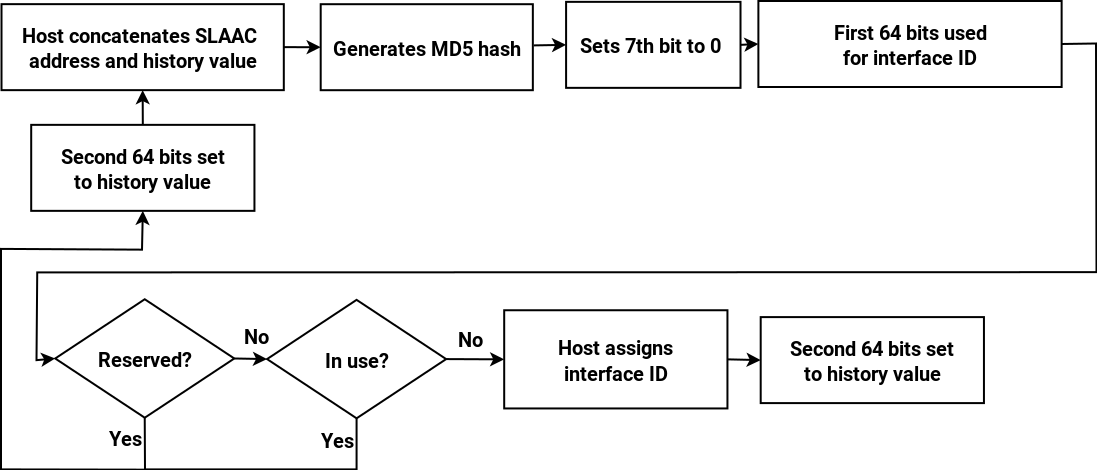In the last post we looked at alternatives to the conventional SLAAC IID, which leaks information about host identity and network interface hardware. However, there’s another problem. With end-to-end IPv6 addressing, the naked subnet ID is also exposed to the outside world. This reveals network identity (you can see which hosts are on the same subnet) and potentially network topology. After all, one of the benefits of IPv6 is that it enables efficient route summarisation in the global Internet, and enterprises are naturally going to want to do that internally on their own networks as well, by structuring their subnets hierarchically (Tom Coffeen’s IPv6 Address Planning recommends that you do it that way, as does RFC 5375). As a consequence, you are advertising information about your internal subnet topology to the outside world, information useful to an attacker.
RFC 4864 attempts to address concern about this in several ways. The first is, well, not to use hierarchical subnetting, and assign subnet IDs from a flat address space. In practice this means running a routeing protocol. Large enterprises will do this anyway, but even so hierarchical addressing simplifies administration and troubleshooting. Many small and medium enterprises have a network topology that’s simple enough not to need an internal routeing protocol at all, especially if subnetting is structured hierarchically. It seems to me that using flat unstructured subnetting exacts a heavy cost.
RFC 4864 proposes a few other solutions. One is to use explicit host routes: individual hosts would be allocated an address from a logical subnet dedicated to the purpose, and those hosts would inject host routes into the interior gateway protocol (IGP) indicating themselves as the gateway to those logical hosts. This requires:
- An IGP
- All hosts to run the IGP
- A lot of routes
As RFC 4864 points out, this isn’t very scalable, as the IGP is likely to have a limit on the maximum number of routes (and the system would get unmanageable well before that). The other main approach that RFC 4864 recommends is the use of a tunnelling mechanism like Mobile IPv6. This requires:
- A Mobile IPv6 Home Agent
- Mobile IPv6 support on every host
- Mobile IPv6 support on the network to allow hosts to find the Home Agent
In short, a very clunky solution. RFC 4864 also suggests a Layer 2 solution, although it acknowledges that this isn’t very practical either.
Despite all these limitations, RFC 4864 considers these solutions good enough for those sites that require topology hiding. I disagree: they place too much burden on the internal hosts and create significant manageability problems. I would like to suggest an alternative: network address encryption (NAE). Let’s suppose we have a site with a /48 IPv6 allocation that wants to hide its internal topology, and a symmetrical cipher with a suitable-length key that can securely encrypt individual 64-bit blocks of data. An NAE gateway located at an enterprise’s boundary could encrypt Bits 48 to 111 (counting from Bit 0) of the source address of any datagram with a destination on the global Internet (outside of the NAE domain). Any datagram coming back from the global Internet via the NAE gateway would have the same bits of its destination address decrypted using the same cipher and key. Such a system would have the following properties:
- It would hide subnet topology, as Bits 48 to 63 would be encrypted.
- It would hide subnet identity (so that you couldn’t tell if two hosts were on the same subnet), as Bits 48 to 63 would be encrypted as a block with Bits 64 to 111 of the IID.
- By design it would not hide host identity, so as not to frustrate lawful intercept. However it could be combined with temporary addresses if a site required that.
- It would hide the interface OID (if the IID is a conventional SLAAC address based on the MAC address of the interface).
- It is a form of one-to-one NAT, so it would not need to modify transport-level ports. It would function purely at Layer 3.
- It would be stateless: any NAE gateway configured with the same cipher and the same key would produce the same encrypted addresses.
It would have the following limitations (among others):
- It would require the recalculation of TCP/UDP/ICMP checksums (and would therefore break IPsec ESP transport mode).
- An Application-Level Gateway would be required for certain applications (see my post on NAT and applications).
- A change of key would break open connections.
- It would require a form of split-brain DNS.
- Internal address assignments would need to be sparse, so that there weren’t long stretches of zeros in the internal address to make attacking the encryption easier.
- Care would still need to be taken to avoid leaking internal addresses within the application data, for example through SMTP headers.
If required the encryption could take place at a deeper offset in the IPv6 address (say, Bits 56 to 119) so that some parts of a site could lie outside the NAE domain. For example a sales department might prioritise agility (the freedom to adopt innovative application architectures) whereas a finance department might prioritise security. To improve performance, the results of encryption could be cached on the NAE gateway.
This back-of-an-envelope idea indicates the way I think topology hiding should be implemented: at the boundary of the enterprise. NAE could be implemented on a perimeter firewall, and hosts within the enterprise would not be burdened with any additional overhead such as running a routeing protocol. NAE would also be less draconian than an alternative like proxying; proxying is practical for proxy-aware applications like HTTP and SMTP, but much less so for others. Like any form of NAT, NAE could cause application problems, but less than NAPT. Above all, enterprises would be free to implement an efficient hierarchical subnet structure.
My next post will look at provider-independent IPv6 addressing.

